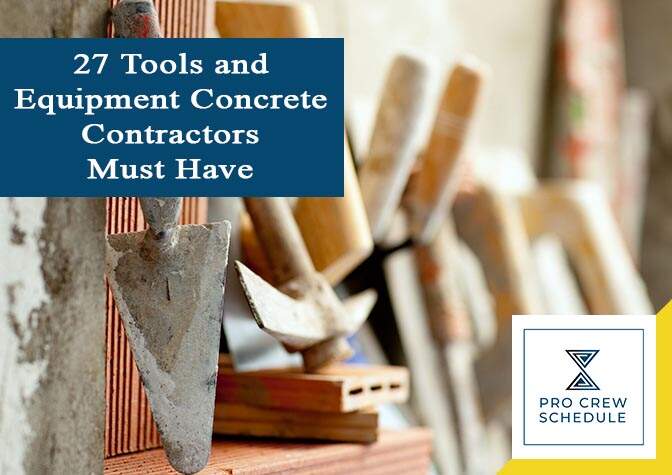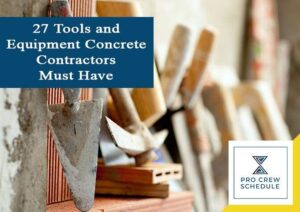Concrete contractors almost always have their plates full. As leaders, they need to be up to date on the latest construction project management trends and construction management technology to manage their crew effectively.
Moreover, they need quite a few tools for their job. There are project management software and construction scheduling software they can choose from on the managing construction side. Each has helpful features like time tracking and crew scheduling to help them stay on top of things.
On the other hand, their job still calls fieldwork. With that, they’re going to need some tools to get the job done. If you’re a seasoned concrete contractor or a newbie, check out our list of tools and equipment concrete contractors need. You might need to spruce up your set or give you an idea of what you need in it.
Concrete Contractors Tools
Tools For Site Preparation
1. Level
The sub-base and the slab surface should be level. While you can use a standard long-line level, a laser level is more accurate, lessens human error, and less time-consuming. Use a level to verify that the slab is up to spec before and after pouring.
2. Compactors and tampers
One of the most important things to do for concrete work to last and remain stable is having a solid and firm tamped stone base. That’s what compactors and tampers are for. They help ensure that the stone base is adequately tamped before adding rebar.
Used with low slump concrete, tampers are used to push the aggregate below the slab surface. Compactors help the stone or aggregate settle into position if the slab’s site is prepped with a sub-base.
3. Vapor barriers
Vapor barriers are not essential to every concrete project, but it is one material that is good always to have handy. Installed before pouring, vapor barriers are any material that prevents moisture from seeping into the concrete slab.
Tools For Pouring Concrete
4. Concrete floats
There are two types of floats. The first is bull floats. These wide-bladed tools are used after the screed work provides the first pass for leveling ridges and filling concrete gaps. The next is magnesium or mag floats. These smaller handheld tools are usually used to float slab edges or for finish work on smaller slabs.
5. Kneeling Boards
Kneeling boards become particularly useful for hand troweling work. They support your weight on wet concrete while allowing you to move along the slab surface fluidly.
6. Mixer
One of the essential pieces of equipment a concrete contractor could have, mixers thoroughly mix the concrete for optimum durability and strength.
7. Rake
A rake is an excellent tool to quickly begin getting the fresh concrete spread more evenly into place. Concrete rakes (or come-along rakes) have a scooped blade that allows for easy pre-leveling. They also have a tine on the back for lifting rebar or mesh into position before the concrete starts to harden.
8. Screed
Basically, screeds serve the purpose of smoothening concrete after it has been poured and moved into place by scraping off excess from the surface. They are available as a specific tool and come in different sizes. However, a screed can also be flat pieces of dimensional planks.
9. Shovels
Shovels are a pretty essential tool but serve a great purpose. Aside from being used to mix manually, this handy tool is used to distribute the concrete around the site for smaller applications and fill in voids left from the pouring stage.
10. Thermo-hygrometer
Because ambient conditions have significant effects on drying time, a thermo-hygrometer is a great tool to have. It monitors the relative humidity (RH) and temperature around the slab to help workers with remediation methods to speed up drying time.
11. Trowels
Like the shovel, Trowels are handheld tools used to smoothen concrete surfaces for their finish coats before leaving them to dry. There are various types of trowels for specific concrete work. Hand-trowelling is typically done for smaller slabs while using power trowels are better done on larger ones.
12. Vibrators
Concrete vibrators are power tools that release excess water and trapped air from the concrete mix. This will help avoid possible problems that would compromise medium to high slump concrete.
13. Wheel Barrow
Wheelbarrows are a simple but valuable tool for onsite concrete work. They are used to transport and move around small quantities of materials around the site, such as cement, concrete, stone, sand, and working tools.
Tools For Finishing
14. Broom
Brooms are not just for cleaning up messes onsite. Traditionally, a broom finish is done on a concrete slab. This is when a broom is drawn across the surface of an almost-dried slab to make it slip-resistant.
15. Concrete moisture meter
Concrete moisture meters are excellent for spot-checking drying slabs and their moisture levels. However, this device only provides an indication of surface conditions, similar to the calcium chloride method or the hood method.
16. Edger
Edgers are designed to round concrete edges for a smooth and rounded finish.
17. Grinder
Grinders are necessary when a slab surface was over-trowelled and excess moisture is trapped inside. Furthermore, these tools can also elevate the aesthetic value, giving it a distressed finish.
18. Hammer drills or power drills
Typically used after the concrete has been poured and leveled, hammer and power drills place anchors in the concrete, drill holes to test relative humidity while the concrete dries, and drill holes for possible attachments and future construction.
Hammer or rotary drills make these tasks easier by using a rotating motion and a pounding motion. The latter breaks up the concrete faster to make installation easier.
19. Hand sprayer
For outdoor concrete work, slabs are usually sprayed with a final compound for curing after they are completely dry. A hand sprayer lets you do this more evenly.
20. Moisture retarder
Vapor or moisture retarders prevent moisture from penetrating the finished concrete slab. These are typically placed under on grade or below grade slabs.
21. Polisher
When the concrete slab is sufficiently dry, you can use a polisher to make a surface finish effect. A polisher can do those from gentle smoothing of the surface for safety and grip to a shiny aesthetic finish.
22. Relative Humidity (RH) test kit
While a thermo-hygrometer is useful, it only reads the moisture on a surface level. On the other hand, an RH test kit provides an accurate moisture read of the internal condition of a drying slab.
This is because RH testing has in situ probes that give an accurate internal moisture measurement. Supported by ASTM F2170, this type of testing offers needed moisture data for concrete workers and contractors to prevent issues related to moisture.
23. Saws
Saws have several uses in concrete work. Circular or reciprocating saws can be used to cut forms or rebar a job site. Additionally, they can be used to deal with problems that develop under the slab. Saws can help remove a portion of that concrete after it’s set and dry to remedy an issue.
24. Tape Measure
Concrete work is a job that requires accuracy and precision, from measuring the components of the mixture to the dimensions of a slab placement. With the latter factor, tape measures are beneficial to have on hand. They can also be used to test placement and mapping before finally setting the slap in place.
Safety Gear and Equipment
25. Gloves
The majority of construction work requires the use of hands, mainly concrete work. Subsequently, this causes a lot of physical stress and strain on the hands. On top of carrying and mixing, plenty of mixes contain admixtures that may cause severe burns when bare skin is exposed for an extended period.
Gloves prevent overexposure and protect your hands from blisters. Make sure to choose one that is durable yet allows flexibility and mobility.
26. Rubber or work boots
Similar to your hands, your feet also need protection on a work site. Durable rubber boots keep your feet safe from falling debris, painful surfaces, and concrete contact with skin. Furthermore, the rubber material lets you easily clean your footwear as concrete is stiff and difficult to clean.
27. Safety glasses
Safety glasses are a standard in most construction sites for any trade. They protect your eyes from dust and debris when grinding, drilling, sawing, or power trowelling concrete.
Don’t settle for less
It’s true that skill is an essential factor in any trade job. However, it takes more than skills to do the job well. Quality tools and equipment are vital to any concrete contractor or worker. With low-quality tools, you will yield subpar results.
While it may be pricey to get your toolset started, it will be well worth it in the long run. Think of it as an investment. When you have a set of high-quality tools and equipment, you’re more likely to do a great job. Consequently, your customers will be overly satisfied, spread the word, and get you more jobs. You’ll make your money back in no time. Plus, durable tools will last you a few years, allowing you to replace them less frequently, which, in turn, saves you money.
And this goes for digital tools, as well. The best construction management software aids you in managing concrete projects, improving productivity and increasing efficiency. With excellent management software, your concrete contracting business will be booming.







